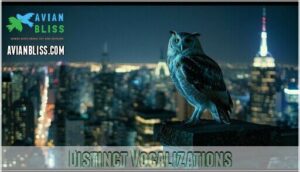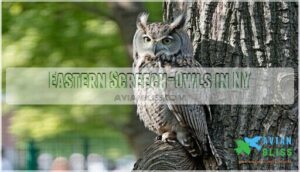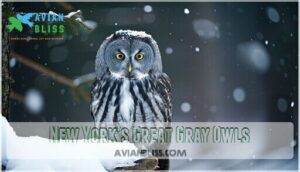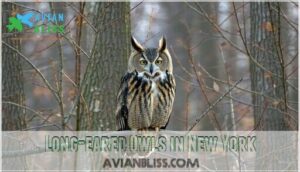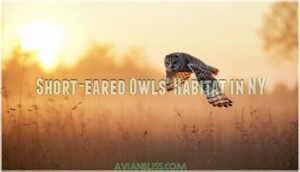This site is supported by our readers. We may earn a commission, at no cost to you, if you purchase through links.

The state is home to eight fascinating species, including the tiny Northern Saw-whet Owl with its wide yellow eyes, and the Snowy Owl, which winters in open fields.
Eastern Screech-Owls are masters of disguise, blending into tree bark so well you might miss them.
The hooting Barred Owl is a year-round resident, often asking “Who cooks for you?”
Long-eared and Short-eared Owls, with their secretive habits, prefer quieter spots.
From grasslands to city parks, there’s always an owl nearby—if you know where to look!
Table Of Contents
- Key Takeaways
- Most Common Owl in New York
- Barn Owls in New York
- Northern Saw-whet Owl Sighting
- Eastern Screech-Owls in NY
- Snowy Owls’ Migration Patterns
- New York’s Great Gray Owls
- Long-eared Owls in New York
- Short-eared Owls’ Habitat in NY
- Barred Owls in New York
- Northern Saw-whet Owl Sighting Tips
- Frequently Asked Questions (FAQs)
- What is the most common owl in NY?
- Are owls good to have in your yard?
- What time of day do owls come out?
- What kind of owls hoot at night?
- How to attract owls to my backyard?
- What is the lifespan of New Yorks owls?
- Are owls nocturnal or diurnal?
- Which owls are commonly seen in the winter?
- Can owls coexist with other bird species?
- What is the lifespan of owls in New York?
- Conclusion
Key Takeaways
- You can spot owls like the Eastern Screech-Owl and Barred Owl year-round, with Great Horned Owls being the most common in New York.
- Snowy Owls stand out in winter with daytime activity, while Northern Saw-whet Owls and Short-eared Owls prefer nocturnal hunting at dawn or dusk.
- Owls thrive in diverse habitats, from city parks and dense forests to open fields and farmlands, showcasing their adaptability to urban and rural settings.
- Attract owls to your backyard by adding owl boxes, keeping outdoor lights low, and avoiding pesticides to create a safe environment.
Most Common Owl in New York
What makes the Great Horned Owl such a standout among New York owls? For starters, their adaptability is unmatched. You’ll find these majestic birds everywhere—from dense forests to city parks—and yes, they’re even part of the NYC wildlife scene.
Known for their iconic ear tufts and fierce yellow eyes, these “tigers of the sky” are born hunters, feasting on everything from rabbits to skunks (yep, skunks!). Despite their abundance, spotting one still feels magical.
Fierce yellow eyes and iconic ear tufts make these born hunters unforgettable, feasting on everything from rabbits to even skunks!
Owl sightings are most likely at dusk or dawn, when they’re out on the hunt. Their skill at adapting to urban settings shows just how resourceful they are.
While their conservation status is stable, threats like habitat loss remind us to protect the spaces they call home. Keep an eye out—you never know when one might silently watch from above!
Barn Owls in New York
You’ll spot Barn Owls year-round in New York, often gliding silently over open fields at night.
Their ghostly, heart-shaped faces and eerie screeches make them both fascinating and a bit spooky to encounter.
Non-migratory Presence
Barn owls in NYC are true homebodies, rarely leaving their territory. They’ve mastered the art of thriving in stable, year-round habitats.
These owls love wide-open spaces like fields and farmlands, where they can hunt rodents efficiently and help keep ecosystems balanced. You’ll often find them nesting in barns, trees, or unexpected hideaways like silos.
They’re nocturnal hunters with an eerie, heart-shaped face that’s impossible to forget. These resident owls are essential to controlling rodent populations in both rural and urban areas.
- Where to Spot: Farmlands and open fields
- Nesting: Barns, trees, silos
- Active Times: Nighttime
- Key Role: Rodent control
- Unique Feature: Heart-shaped face
Distinct Vocalizations
You know those high-pitched screams that could send shivers down your spine? That’s how barn owls talk! Their owl calls aren’t just spooky; they’re downright fascinating.
These eerie bird sounds serve as warnings to rivals or love songs to mates. Amazingly, owl communication varies by region, almost like bird accents.
| Purpose | Description | Fun Fact |
|---|---|---|
| Warning Signal | Screeches to ward off rivals | Can sound like a shriek |
| Mating Call | High-pitched to attract a mate | Unique to each owl region |
| Territorial Defense | Loud calls to protect their area | Heard mostly at night |
Northern Saw-whet Owl Sighting
You’ll need a sharp eye to spot the Northern Saw-whet Owl, New York’s smallest owl with a charmingly round appearance.
Look for their bright yellow eyes peeking out from dense forests, especially during quiet evenings.
Small, Round Appearance
The Northern Saw-whet Owl is like a pint-sized mystery wrapped in feathers.
Its small size, smooth plumage, and perfectly rounded facial discs highlight its wide-eyed, almost cartoon-like appearance.
This owl’s “roundness advantage” gives it a soft, approachable look, making it a favorite among bird lovers in New York.
Juvenile owls crank up the cute factor even more with their fluffy feathers and curious expressions.
- Picture this: A tiny owl perched on a branch, its brilliant facial discs tilted in wonder, showcasing impeccable feather arrangement.
Observing Yellow Eyes
Those yellow eyes of Northern Saw-whet Owls aren’t just enchanting—they’re a perfect example of nocturnal vision in action.
These little hunters use their incredible light sensitivity during moonlit hunts, blending into trees like expert magicians.
If you’re into owl watching or birdwatching in New York, you might spot them in places like Central Park.
Remember, these masters of camouflage prefer peace, so tread softly—it’s all about respecting wildlife in New York.
Eastern Screech-Owls in NY
You’ll find Eastern Screech-Owls blending perfectly into tree bark, thanks to their camouflaged feathers.
These charming little owls are year-round residents in New York, thriving in parks, wooded areas, and even neighborhood backyards.
Camouflaged Morphs
Eastern Screech-Owls come in two striking color variations: gray and orange.
These plumage patterns are nature’s perfect disguise, letting them blend seamlessly into their habitat camouflage.
The gray morph mimics tree bark, while the orange shines during autumn’s seasonal changes.
Their cryptic behavior makes them nearly invisible, but it’s all part of their smart owl adaptations.
Finding them is like solving a puzzle—try spotting one next time you’re near some dense trees. Bet they’ll win!
Versatile Habitat
Eastern Screech-Owls are champions of adaptation, making themselves at home in almost any environment—urban or wild.
From the vibrant chaos of city parks like Central Park to quiet wooded areas, these urban owls know how to thrive.
Habitat loss and climate impact haven’t slowed them down either.
Here’s what makes their habitats unique:
- Urban Adaptations: They blend into noisy, green city spaces.
- Forest Diversity: Screech-Owls nest in tree cavities seamlessly.
- Nesting Preferences: From barns to parks, they adapt well.
- Evening Hunting: Sundown signals snack time.
Snowy Owls’ Migration Patterns
Spotting a Snowy Owl in New York feels like glimpsing a celebrity in a winter coat.
Wrapped in Arctic breeding brilliance, these owls migrate south when prey availability dips or climate change shifts their tundra homes.
Winter irruptions bring them to places like Shirley Chisholm State Park, perching on open fields or fences.
Unlike most owls, they’re daytime hunters, so keep your eyes peeled for these mesmerizing ambassadors of unpredictable bird migration, triggered by food scarcity and weather changes.
Don’t miss nature’s frosty marvel!
New York’s Great Gray Owls
The Great Gray Owl is a breathtaking rarity in NY, with its massive frame, somber gray plumage, and iconic round face.
Dubbed "phantoms of the north," they haunt cold, boreal forests but rarely wander south unless harsh winters drive them.
Here’s what makes them special:
- Piercing yellow eyes that seem to stare into your soul.
- Expert hearing, allowing them to hunt prey hidden under snow.
- Impressive size, making them one of the largest owl species in New York.
- Fascination with voles as their favorite meal.
Spotting this elusive owl feels like glimpsing a ghost of New York wildlife.
Long-eared Owls in New York
You’ll need patience to spot a Long-eared Owl in New York—they love staying hidden in dense forests and thickets.
Their tall ear tufts and mottled brown feathers make them masters of disguise, blending right into the trees.
Secretive Nature
Long-eared Owls are experts at staying out of sight, thanks to their Nocturnal Behavior and Camouflage Techniques.
These nocturnal birds thrive in Hidden Habitats, like dense woods or quiet parks.
Their Silent Flight and Evasive Tactics make them elusive hunters.
Listen carefully for their eerie owl calls:
- A low, single “woop.”
- Creepy screeches.
- Bizarre, dog-like barks.
Large Ear Tufts
You’ll spot Long-eared Owls by their tall, exclamation mark-like ear tufts.
While they don’t help with hearing enhancement, these tufts play a big role in camouflage, blending in like twigs.
This medium-sized owl, with its orange face and lanky frame, is perfect for owl identification.
Unlike the chatty Eastern Screech-Owl, Long-eared Owls stay secretive, thriving in New York’s diverse owl habitats.
Short-eared Owls’ Habitat in NY
You’ll find Short-eared Owls gliding low over New York’s open fields and grasslands, especially at dawn or dusk.
Their acrobatic flight is a sight to see, almost like they’re showing off their aerial skills.
Grassland Preference
In grasslands, Short-eared Owls rely on prey abundance, mostly voles and mice, to survive.
Their nesting sites are well-hidden by tall grass, making them tricky to spot. Habitat loss is their biggest challenge, but conservation efforts aim to protect these open spaces.
Using a realistic owl figure can sometimes aid in observing their behavior.
Here’s why grasslands matter:
- Food-rich hunting grounds.
- Ideal nesting spots.
- Seasonal resting areas.
- Critical for owl conservation.
Acrobatic Flight Behavior
Short-eared Owls are like aerial acrobats, blending Nocturnal Agility with silent flight as they glide low over fields.
Their hunting dives are a masterclass in owl behavior, relying on sharp vision, feather adaptations, and precise moves to nab small mammals like voles and mice.
You’ll often catch this bird species behavior at dusk when their graceful flight feels almost choreographed.
Consider unique owl-themed presents for the owl enthusiast in your life.
Their ability to scan the ground while in motion, coupled with near-magical head rotation, makes watching their owl hunting techniques a real treat in open spaces.
Barred Owls in New York
Barred Owls stick around New York year-round, so you’ve got plenty of chances to spot them in the woods.
Their hoooting call, which sounds like "Who cooks for you?", is as charming as it’s unmistakable.
Year-round Presence
Barred Owls are year-round residents, thriving in New York’s forests, parks, and neighborhoods.
Their survival secrets include:
- Territorial nature guarantees stable owl habitats.
- Breeding habits adapted for consistency across seasons.
- Dense plumage protects them from chilly winters.
- A versatile diet covers rodents, insects, and more.
- Access to diverse wildlife habitats in New York supports their population.
Their distinctive vocalizations include a recognizable eight-hoot call.
Distinctive Who Cooks for You Call
Ever heard a Barred Owl’s famous “Who cooks for you?” It’s not dinner planning—it’s their territorial anthem, echoing through New York’s forests year-round.
Who cooks for you? A Barred Owl’s haunting melody turns New York’s forests into a natural symphony year-round.
These owl calls fascinate bird lovers, blending acoustic ecology with playful human perception. Their deep hoots are even mimicked by locals for fun!
- Quick Facts: Large, dark eyes; brown and white streaks; vocal variations tied to regions; and a flair for unforgettable bird calls.
Northern Saw-whet Owl Sighting Tips
You’ll need a sharp eye and a quiet approach to spot the Northern Saw-whet Owl, one of New York’s smallest and most secretive owls.
Look for them in dense forests at dusk or after dark when their soft, toot-like calls give them away.
Identifying Characteristics
Spotting a Northern Saw-whet Owl feels like meeting nature’s tiniest woodland neighbor.
These owls are small, only 6.5-9 inches, smaller than a soda can. Look for their white facial discs and streaked brown plumage that blends with conifer thickets.
Striking yellow eyes and their soft “toot-toot” whistle make them stand out. Want help with owl identification? Carry an owl identification guide for better tips.
Remember, their petite size and gorgeous plumage variations make them unforgettable.
Preferred Viewing Times
Northern Saw-whet Owls thrive on their nocturnal habits, making dusk and early morning perfect for observing their dawn/dusk activity.
Fall and winter bring seasonal changes, boosting your chances of spotting them. Keep an eye on clear, calm nights—weather influences their behavior.
Explore owl watching locations like Central Park owls or wooded, dense cover areas. Birdwatching here? Bring binoculars—nature’s secrets await!
- Watch at twilight during January to May.
- Search dense conifers or cypress near water.
- Favor birdwatching locations with quiet conditions.
Frequently Asked Questions (FAQs)
What is the most common owl in NY?
Funny how nature works, isn’t it?
The Great Horned Owl reigns as New York’s most common owl.
Its nighttime calls and fierce hunting skills make it a familiar yet elusive neighbor in woods and urban sprawl.
Are owls good to have in your yard?
Having owls in your yard is great.
They naturally control pests like mice and insects.
Plus, their hoots and presence add a magical touch to your nights.
Just keep outdoor lights low to attract them.
What time of day do owls come out?
Owls are most active from dusk to dawn.
They’re night owls—literally—hunting under moonlight while the world’s asleep.
If you’re lucky, you might spot one perched silently, blending perfectly with its surroundings.
What kind of owls hoot at night?
Imagine a forest lullaby—Great Horned Owls call with low hoots, Barred Owls shout “Who cooks for you?”, and Eastern Screech Owls whistle hauntingly.
These nighttime singers keep nature’s concert alive while the world sleeps.
How to attract owls to my backyard?
Create a safe, quiet space with trees or tall shrubs.
Install owl boxes near open areas.
Avoid pesticides and offer fresh water. They’ll appreciate the rodent buffet from an unkempt garden or backyard.
What is the lifespan of New Yorks owls?
Most owls in New York live 10-15 years in the wild, though larger species like Great Horned Owls can reach
In captivity, they enjoy longer lives—some reaching 30 years or more.
Are owls nocturnal or diurnal?
Think of them as creatures of the night—most owls are nocturnal, hunting under moonlight with soundless wings and sharp vision.
Some, like the Snowy Owl, bend the rules, being active during daytime in winter.
Which owls are commonly seen in the winter?
In winter, you’ll likely spot Snowy Owls perched in open fields or shorelines.
Short-eared Owls show up, too, flying over grasslands at dusk.
Rare gems like Northern Hawk Owls occasionally visit from colder regions.
Can owls coexist with other bird species?
Owls can coexist with other birds, but it depends on the species.
Some owls, like Great Horned Owls, hunt smaller birds, while others avoid them.
Habitat and food availability play a big role in peaceful coexistence!
What is the lifespan of owls in New York?
Most owls in New York live around 10-20 years in the wild, depending on their species and environment.
With proper care in captivity, some have been known to live over 30 years!
Nature’s long-lived night hunters!
Conclusion
Spotting owls in New York might sound tricky, but with patience and a sharp eye, it’s easier than you think.
From the camouflaged Eastern Screech-Owl to the majestic Snowy Owl, each species offers something special.
Remember to look in diverse habitats like city parks, forests, and grasslands, and use binoculars and quiet observation as your best tools.
Keep an ear out, too—owls are often heard before they’re seen.
They’re closer than you realize, so happy owl-watching!


